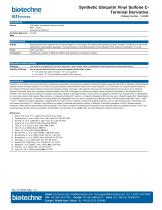 Website:
R&D Systems
Website:
R&D Systems
Catalog excerpts

Synthetic Ubiquitin Vinyl Sulfone C-Terminal Derivative Catalog Number: U-202BDESCRIPTION Source Chemically Synthesized Ubiquitin protein Met1 - Gly75 Accession # P0CG47.1 Predicted Molecular 8.6 kDa Mass Activity Recombinant Human Ubiquitin-Vinyl Sulfone added to in vitro assays will inhibit deubiquitinating enzymes. Reaction conditions will need to be optimized for each specific application. We recommend an initial Recombinant Human Ubiquitin-Vinyl Sulfone concentration of 1-5 gM. Purity >95%, by HPLC. Formulation Supplied as a solution in MES and DMSO. See Certificate of Analysis for details. Shipping The product is shipped with dry ice or equivalent. Upon receipt, store it immediately at the temperature recommended below. Stability & Storage Use a manual defrost freezer and avoid repeated freeze-thaw cycles. • 6 months from date of receipt, -70 °C as supplied. • 3 months, -70 °C under sterile conditions after opening. Ubiquitin is a 76 amino acid (aa) protein that is ubiquitously expressed in all eukaryotic organisms. Ubiquitin is highly conserved with 96% aa sequence identity shared between human and yeast Ubiquitin, and 100% aa sequence identity shared between human and mouse Ubiquitin (1). In mammals, four Ubiquitin genes encode for two Ubiquitin-ribosomal fusion proteins and two poly-Ubiquitin proteins. Cleavage of the Ubiquitin precursors by deubiquitinating enzymes gives rise to identical Ubiquitin monomers each with a predicted molecular weight of 8.6 kDa. Conjugation of Ubiquitin to target proteins involves the formation of an isopeptide bond between the C-terminal glycine residue of Ubiquitin and a lysine residue in the target protein. This process of conjugation, referred to as ubiquitination or ubiquitylation, is a multi-step process that requires three enzymes: a Ubiquitin-activating (E1) enzyme, a Ubiquitin-conjugating (E2) enzyme, and a Ubiquitin ligase (E3). Ubiquitination is classically recognized as a mechanism to target proteins for degradation and as a result, Ubiquitin was originally named ATP-dependent Proteolysis Factor 1 (APF-1) (2,3). In addition to protein degradation, ubiquitination has been shown to mediate a variety of biological processes such as signal transduction, endocytosis, and post-endocytic sorting (4-7). Ubiquitin-Vinyl Sulfone is a potent, irreversible and specific inhibitor of Ubiquitin C-terminal hydrolases (UCHs), Ubiquitin-specific proteases (USPs) and deubiquitinating enzymes (DUBs). This protein is useful for inhibiting the hydrolysis of poly-Ubiquitin chains on substrate proteins in vitro, thus enhancing poly-Ubiquitin chain accumulation. Some DUBs, such as those of the JAMM class, are not inhibited by Ubiquitin-Vinyl Sulfone. References: 1. Sharp, P.M. & W.-H. Li. (1987) Trends Ecol. Evol. 2:328. 2. Ciechanover, A. et al. (1980 ) Proc. Natl. Acad. Sci. USA 77:1365. 3. Hershko, A. et al. (1980) Proc. Natl. Acad. Sci. USA 77:1783. 4. Greene, W. et al. (2012) PLoS Pathog. 8:e1002703. 5. Tong, X. et al. (2012) J. Biol. Chem. 287:25280. 9. Borodovsky A., et al. (2002) Chem. Biol. 9: 1149-1159. 10. Borodovsky A., et al. (2005) Chem. Biochem. 6: 287-291. 13. Misaghi S., et al. (2005) J. Biol. Chem. 280: 1512-1520. Global bio-techne.com info@bio-techne.com techsupport@bio-techne.com TEL +1612 379 2956 USA TEL 800 343 7475 Canada TEL 855 668 8722 China TEL +86 (21) 52380373 Europe | Middle East | Africa TEL +44 (0)1235 529449
Open the catalog to page 1All R&D Systems catalogs and technical brochures
-
DuoSet™ Ancillary Products
3 Pages
-
Recombinant Human Ubiquitin
1 Pages
-
Recombinant Human IgG1 Fc
1 Pages
-
Recombinant Human Activin A
2 Pages
-
DuoSet™ Ancillary Products
3 Pages
-
Mg-ATP Solution
1 Pages




















